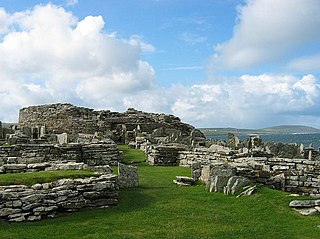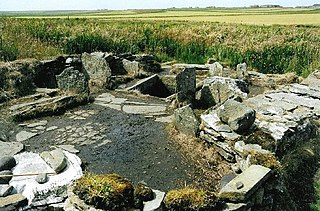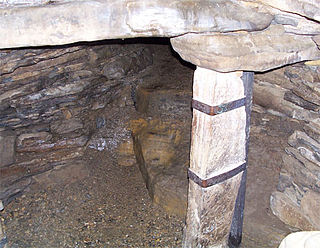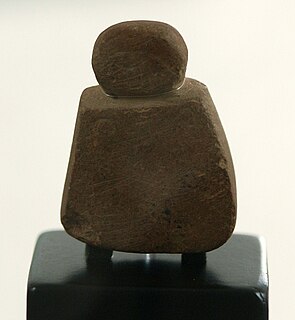 W
WPrehistoric Orkney refers to a period in the human occupation of the Orkney archipelago of Scotland that was the later part of these islands' prehistory. The period of prehistory prior to occupation by the genus Homo is part of the geology of Scotland. Although some written records refer to Orkney during the Roman invasions of Scotland, prehistory in northern Scotland does not end until the commencement of the Early Historic Period around AD 600.
 W
WThe Neolithic Barnhouse Settlement is sited by the shore of Loch of Harray, Orkney Mainland, Scotland, not far from the Standing Stones of Stenness, about 5 miles north-east of Stromness.
 W
WBlackhammer Chambered Cairn is a Neolithic cairn on Rousay, in Orkney, Scotland. It is a scheduled monument in the care of Historic Environment Scotland.
 W
WThe Broch of Borwick is an Iron Age broch located on Mainland, Orkney, Scotland. It is a scheduled monument.
 W
WThe Broch of Burrian is an Iron Age broch located on North Ronaldsay in the Orkney Islands, in Scotland.
 W
WThe Broch of Gurness is an Iron Age broch village on the northeast coast of Mainland Orkney in Scotland overlooking Eynhallow Sound, about 15 miles north-west of Kirkwall. It once housed a substantial community.
 W
WThe Brough of Birsay is an uninhabited tidal island off the north-west coast of The Mainland of Orkney, Scotland, in the parish of Birsay. It is located around 13 miles north of Stromness and features the remains of Pictish and Norse settlements as well as a modern light house.
 W
WBurroughston Broch is an Iron Age broch located on the island of Shapinsay in the Orkney Islands, in Scotland. The site overlooks the North Sea on the northeast part of Shapinsay. Excavated in the mid 19th century, Burroughston Broch is still well-preserved. The drystone walls are up to four metres thick in some parts and there is a complete chamber intact off the entrance passage. Some remains of stone fittings are evident in the interior.
 W
WCastle Bloody is a prehistoric feature on the island of Shapinsay, Orkney, Scotland. Hogan observes that while the feature is marked as a chambered mound on the UK Ordnance Survey map, the structure is more properly and specifically classified as a souterrain or earth house. Slightly to the north is located the ruined historic Linton Chapel.
 W
WCuween Hill Chambered Cairn is a Neolithic chambered cairn on Mainland, the main island of Orkney, Scotland, about 6 miles west of Kirkwall. It dates to around 3,000 BCE, and is similar in design to Maeshowe, but on a smaller scale. It was constructed by Neolithic farmers as a burial place.
 W
WHeart of Neolithic Orkney refers to a group of Neolithic monuments found on the Mainland of the Orkney Islands, Scotland. The name was adopted by UNESCO when it proclaimed these sites as a World Heritage Site in 1999.
 W
WThe Knap of Howar on the island of Papa Westray in Orkney, Scotland is a Neolithic farmstead which may be the oldest preserved stone house in northern Europe. Radiocarbon dating shows that it was occupied from 3700 BC to 2800 BC, earlier than the similar houses in the settlement at Skara Brae on the Orkney Mainland.
 W
WLiddle Burnt Mound is a Bronze Age site on the island of South Ronaldsay, Orkney. The site consists of the remains of a building and a mound that surrounds it on three sides. The purpose of the site is controversial, but most investigators believe burnt mounds hosted a "domestic function", perhaps related to cooking.
 W
WThe Dwarfie Stane is a megalithic chambered tomb carved out of a titanic block of Devonian Old Red Sandstone located in a steep-sided glaciated valley between the settlements of Quoys and Rackwick on Hoy, an island in Orkney, Scotland. The stone is a glacial erratic located in desolate peatland.
 W
WLinks of Noltland is an archaeological site near Grobust Bay on the north coast of Westray in Orkney, Scotland. The site contains the remains of both a Neolithic village and later Bronze Age dwellings.
 W
WMaeshowe is a Neolithic chambered cairn and passage grave situated on Mainland Orkney, Scotland. It was probably built around 2800 BC. In the archaeology of Scotland, it gives its name to the Maeshowe type of chambered cairn, which is limited to Orkney. Maeshowe is a significant example of Neolithic craftsmanship and is, in the words of the archaeologist Stuart Piggott, "a superlative monument that by its originality of execution is lifted out of its class into a unique position." Maeshowe is a scheduled monument and is part of the "Heart of Neolithic Orkney", a group of sites including Skara Brae, which were designated a UNESCO World Heritage Site in 1999.
 W
WMidhowe Broch is an iron-age broch located on the west coast of the island of Rousay in the Orkney Islands, in Scotland.
 W
WMidhowe Chambered Cairn is a large Neolithic chambered cairn located on the south shore of the island of Rousay, Orkney, Scotland. The name "Midhowe" comes from the Iron Age broch known as Midhowe Broch, that lies just west of the tomb. The broch got its name from the fact that it's the middle of three such structures that lie grouped within 500 metres (1,600 ft) of each other and Howe from the Old Norse word haugr meaning mound or barrow. Together, the broch and chambered cairn form part of a large complex of ancient structures on the shore of Eynhallow Sound separating Rousay from Mainland, Orkney.
 W
WMor Stein is a neolithic standing stone in the southeastern part of the island of Shapinsay, Orkney Islands, Scotland. Shapinsay is one of the two large inner islands of the Orkney group, and it is situated approximately two miles north of the Orkney Mainland. Linton Bay is situated slightly to the northeast of Mor Stein.
 W
WThe Ness of Brodgar is an archaeological site covering 2.5 hectares between the Ring of Brodgar and the Stones of Stenness in the Heart of Neolithic Orkney World Heritage Site in Orkney, Scotland. Excavations at the site began in 2003. The site has provided evidence of decorated stone slabs, a stone wall 6 metres (20 ft) thick with foundations, and a large building described as a Neolithic temple. The earliest structures were built between 3,300 and 3,200 BCE, and the site had been closed down and partly dismantled by 2,200 BCE.
 W
WRennibister Earth House is located on the Mainland of Orkney, in Scotland. It is located by the south eastern shore of the Bay o' Firth, in a farm yard and is accessed by a hatch in the roof of the earth house and by a ladder. Its location is more picturesque than that of its counterpart, Grain Earth House.
 W
WThe Ring of Brodgar is a Neolithic henge and stone circle about 6 miles north-east of Stromness on the Mainland, the largest island in Orkney, Scotland. It is part of the UNESCO World Heritage Site known as the Heart of Neolithic Orkney.
 W
WSkara Brae is a stone-built Neolithic settlement, located on the Bay of Skaill on the west coast of Mainland, the largest island in the Orkney archipelago of Scotland. Consisting of eight clustered houses, it was occupied from roughly 3180 BC to about 2500 BC and is Europe's most complete Neolithic village. Skara Brae gained UNESCO World Heritage Site status as one of four sites making up "The Heart of Neolithic Orkney". Older than Stonehenge and the Great Pyramids, it has been called the "Scottish Pompeii" because of its excellent preservation.
 W
WThe Standing Stones of Stenness is a Neolithic monument five miles northeast of Stromness on the mainland of Orkney, Scotland. This may be the oldest henge site in the British Isles. Various traditions associated with the stones survived into the modern era and they form part of the Heart of Neolithic Orkney World Heritage Site. They are looked after by Historic Environment Scotland as a scheduled monument.
 W
WTaversöe Tuick is a Neolithic burial cairn on Rousay, Orkney, Scotland, thought to date from between 4000 and 2500 BCE. The monument includes a rare example of a double-tiered chamber, an upper chamber approached via a passageway and a lower subterranean chamber, originally separate, which can now be reached via a modern ladder from the upper chamber. It is unknown why the chambers were stacked in this way. The monument includes a third miniature chamber slightly downhill of the lower chamber, and linked to it by a small channel which has sometimes been called a 'drain' although that is not believed to be its true purpose.
 W
WThe Tomb of the Eagles, or Isbister Chambered Cairn, is a Neolithic chambered tomb located on a cliff edge at Isbister on South Ronaldsay in Orkney, Scotland. First explored by Ronald Simison, a farmer, when digging flagstones in 1958, he conducted his own excavations at the site in 1976. Alerted by Simison, archaeologist John Hedges then mounted a full study, prepared a technical report and wrote a popular book that cemented the tomb's name.
 W
WUnstan is a Neolithic chambered cairn located about 2 miles (3 km) north-east of Stromness on Mainland, Orkney, Scotland. The tomb was built on a promontory that extends into the Loch of Stenness near the settlement of Howe. Unstan is notable as an atypical hybrid of the two main types of chambered cairn found in Orkney, and as the location of the first discovery of a type of pottery that now bears the name of the tomb. The site is in the care of Historic Environment Scotland as a scheduled monument.
 W
WUnstan ware is the name used by archaeologists for a type of finely made and decorated Neolithic pottery from the 4th and 3rd millennia BC. Typical are elegant and distinctive shallow bowls with a band of grooved patterning below the rim, a type of decoration which was created using a technique known as "stab-and-drag". A second version consists of undecorated, round-bottomed bowls. Some of the bowls had bits of volcanic rock included in the clay to make them stronger. Bone tools were used to burnish the surfaces to make them shiny and impermeable.
 W
WThe Westray Wife is a small Neolithic figurine, 4 centimetres (1.6 in) in height, carved from sandstone. It was discovered during an Historic Scotland dig at the Links of Noltland, on Westray, Orkney, Scotland, in the summer of 2009. It was the first Neolithic carving of a human form to have been found in Scotland, and to date it is the earliest depiction of a face found in the United Kingdom.